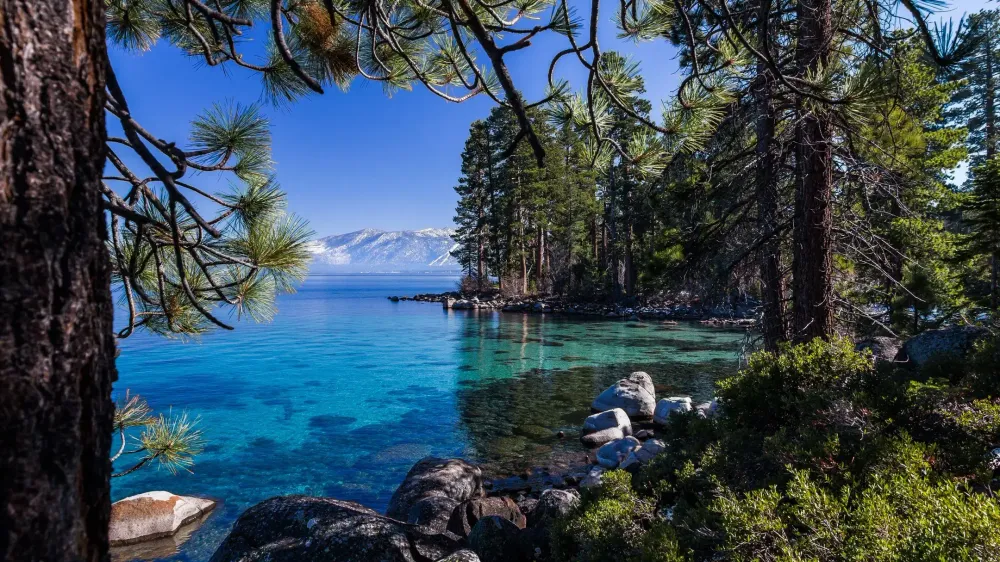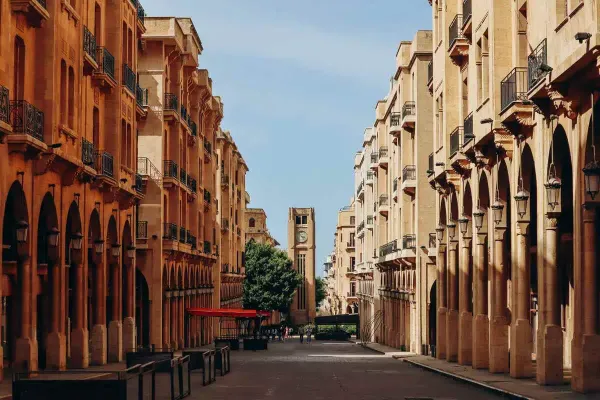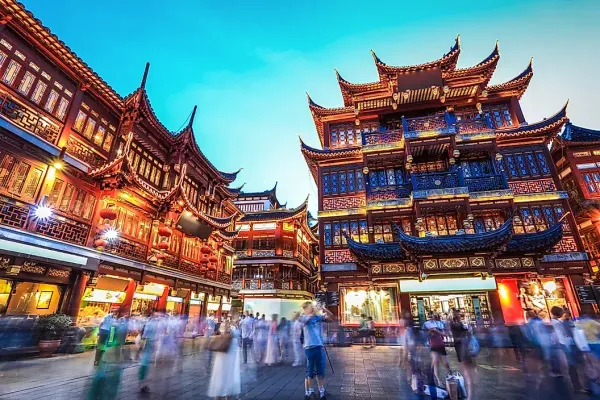6 Wild Swimming Spots in California, Beyond the Coast
The essence of California is not its iconic cities or coastline. The truest form of the state lies in its freshwater, in all its untamed glory. At least, for my family.
My partner Caroline Clements and I are passionate about water and wilderness, having spent the past decade chronicling swimming adventures worldwide. Recently, we returned to California to delve deeper, loading up an old motor home with our toddler, and spent six months roaming the state in search of the best swimming spots.
The diversity of California's landscapes continues to astonish us. Mountain lakes and redwood forests. Granite canyons and emerald pools. Volcanic peaks and hot springs. The meandering rivers that sustain the state. These wild, inland swims captivate us the most.
Below are six freshwater locations that represent the best of the state. This is by no means exhaustive but a starting point for your own explorations. Be safe and use good judgment. Enjoy them wholeheartedly and share them with those you cherish. Most importantly, treat them with respect so others can enjoy them in the future.
1. Budd Lake, Yosemite National Park
Budd Lake epitomizes the beauty of Yosemite’s High Sierra, the vast granite expanse of high-elevation mountains, meadows, and lakes intersected by Tioga Road, an extension of Highway 120. This small blue gem nestles in the Cathedral Range, a minor sub-range of the Sierra Nevada entirely within Yosemite National Park. It's a compact playground of water and stone with endless combinations of backcountry hikes, swims, and climbs. While many first-time visitors are drawn to the stunning Yosemite Valley, the High Sierra remains blissfully untouched by the modern world.
This is a backcountry hike, so stop at Tuolumne Meadows Wilderness Center to pick up a map and discuss the route. It’s about five miles round trip to Budd Lake, starting from Cathedral Lakes Trailhead in Tuolumne Meadows. After about a mile, turn left onto an unmaintained backcountry trail used by climbers to reach Cathedral Peak, marked by a signpost with a carabiner clip illustration. Follow the rough trail along Budd Creek. As long as you keep following Budd Creek upstream, you will arrive.
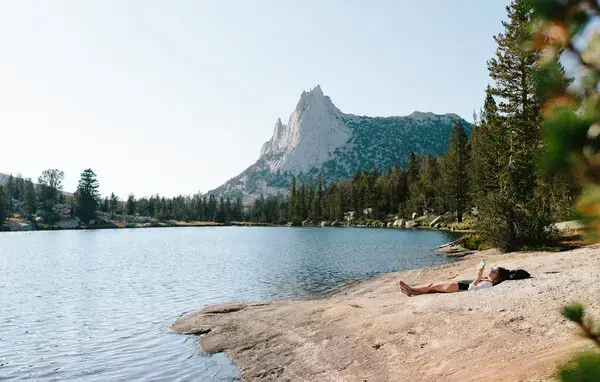
Budd Lake sits in a perfect glacial cirque at the base of Echo Peaks and Cockscomb, two nearby summits. Polished granite slabs form gently sloping beaches into the clear, cold water. It’s easy to spend a whole day lounging in the sun with a book, lost in the timelessness of geologic time. It would have been exactly the same here 5,000 years ago (20,000 years ago, however, you would have been under 1,000 feet of ice). The only sign of the outside world is carried on the breeze from Cathedral Peak — the indistinct voices of climbers. It’s the perfect Yosemite experience, without the crowds (standard vehicle fee is $35, and a park entry reservation is required during summer months).
2. Gualala River, Mendocino County
The Gualala River, pronounced (“wa-LAL-la”), marks the border between Sonoma and Mendocino counties in Northern California. Its winding form cuts a lazy path through ancient redwood forests to ultimately form an estuary beneath windswept coastal bluffs. Just inland, the river is breathlessly still, wrapping itself around Gualala River Redwood Park to form one of the best campground and swimming hole combinations in the state. A boom gate separates this tranquil campground from the outside world. There is no day use allowed, so you must be a registered camper or their guest to enter. Beneath the dense canopy, much of the property sits in perpetual twilight. The forest trails are dusted with soft redwood needles, campsites are divided by wild sorrel and ferns. The silence here is so complete that it becomes addictive. It spreads across the forest like freshly fallen snow, distorting our sense of time. For once, my wife and I sleep like two people who are not living in an RV with a toddler.
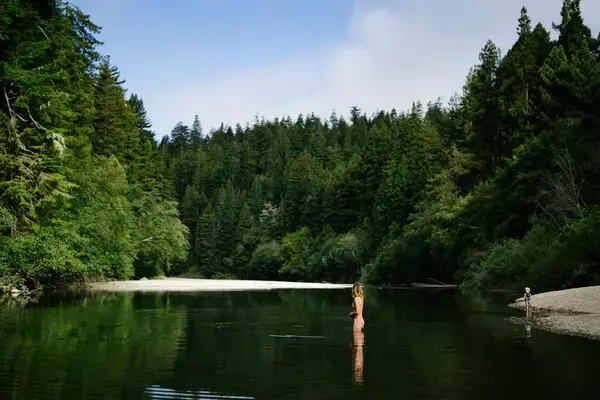
The most coveted spots overlook the river, whose current carves deep green pools as it arcs around the pebble beach (a river-view campsite is $90 a night). As the fog retreats, sunlight pierces the impossibly clear water and warms the dark sand below. People dive in with whoops of delight. Native coho salmon and steelhead trout glide in the shadowy depths, seemingly unfazed by the commotion. Lost among the trees, Gualala feels like an outlier, setting its own rhythms and casting a spell on all who visit.
3. Purdon Crossing, Yuba River South Fork
The South Fork of the Yuba River carves a deep canyon from the crest of the Sierra Nevada to the Sacramento Valley. For much of the year, it roils with white water, surging across the bedrock and tumbling into gorges. By late June or July, just as the summer heat becomes unbearable and cicadas reach their electric crescendo, the river drops to reveal placid, emerald pools and sandy beaches. Smooth granite slabs sparkle in the sun. It’s worth the wait.
For the nearby towns of Nevada City and Grass Valley, the South Yuba is the community pool. People swim in almost every beautiful inch of this river, but Purdon Crossing, a historic steel bridge, has become our preferred access point. The bridge sits squarely in our swimming Goldilocks zone — just far enough from major roads to reduce would-be visitors, yet beaches are abundant and easily accessible from the parking area.
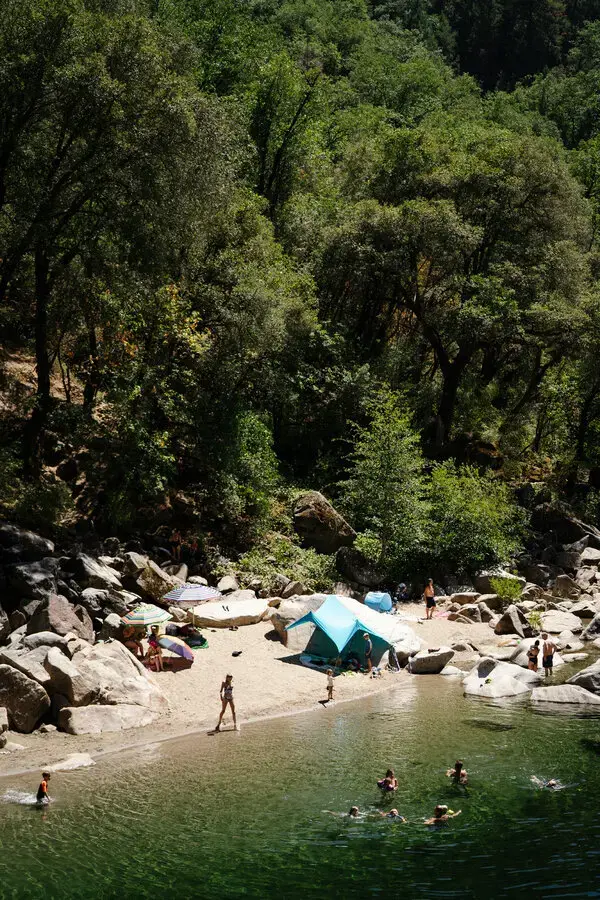
The South Yuba Trail traces the riverbank upstream. After about a quarter mile, a path drops down to Mother’s Beach. This wide, slow-moving section of the river has a gentle, sandy entrance, and is where families often gather. There’s plenty of space, and you could happily spend the entire day here. But we like to go farther upstream one mile to China Dam, where the remnants of a mining diversion dam mark an exquisite pool flanked by high rocks. The cold, clear water is irresistible. Swims like this are the epitome of summer in California’s Gold Country. We immediately strip down and leap from the rocks. Clothing is optional here, but swimming is not.
4. Red Rock Pools, Santa Ynez River
The best wild swimming holes are a perfect expression of the environment and, by extension, the local culture. In the case of the Santa Ynez Valley, just north of Santa Barbara, the same conditions that make it an excellent wine region are what define it as a great place to swim. It’s hot and sunny, yet there is far more water than you would expect. Down in the valley, along the Santa Ynez River, is where the best swimming can be found.
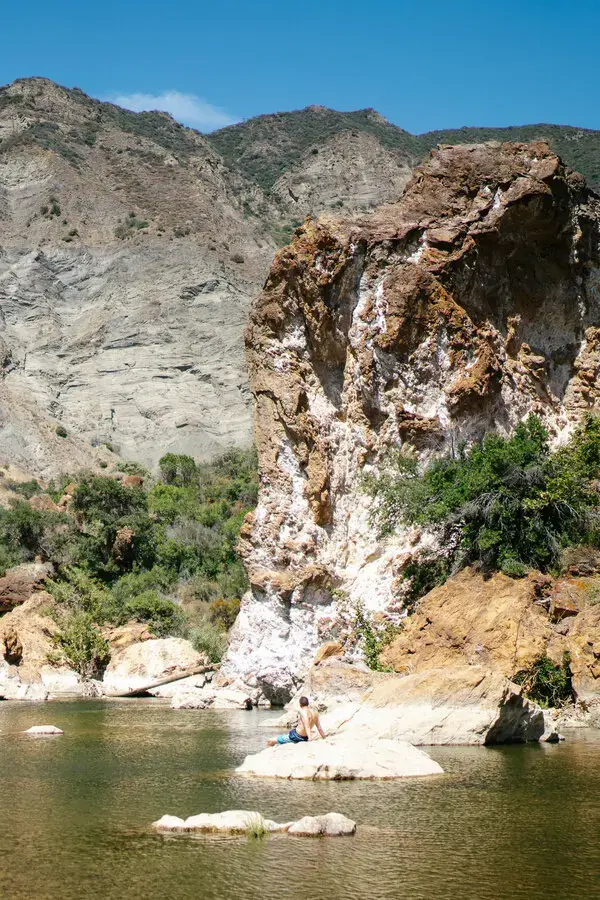
To get there, drive along Paradise Road until it crosses the Santa Ynez River at First Crossing Kiosk ($10 day use fee). When water levels get high, in spring and early summer, rangers are quick to close the road to vehicles but still allow access on foot and bicycle. Over the next five miles, the canyon walls grow higher, and the swimming holes get deeper until the road ends at Red Rock Trailhead.
Even if it looks dry at the trailhead, there is always a place to swim at Red Rock Pools, which are fed by perennial springs. It’s an easy half-mile walk along the Gibraltar Trail to the largest and most reliable swimming hole. The singular Red Rock looms high over the water, with deep, cool pools at its base. It’s the kind of place you can spend all day luxuriating.
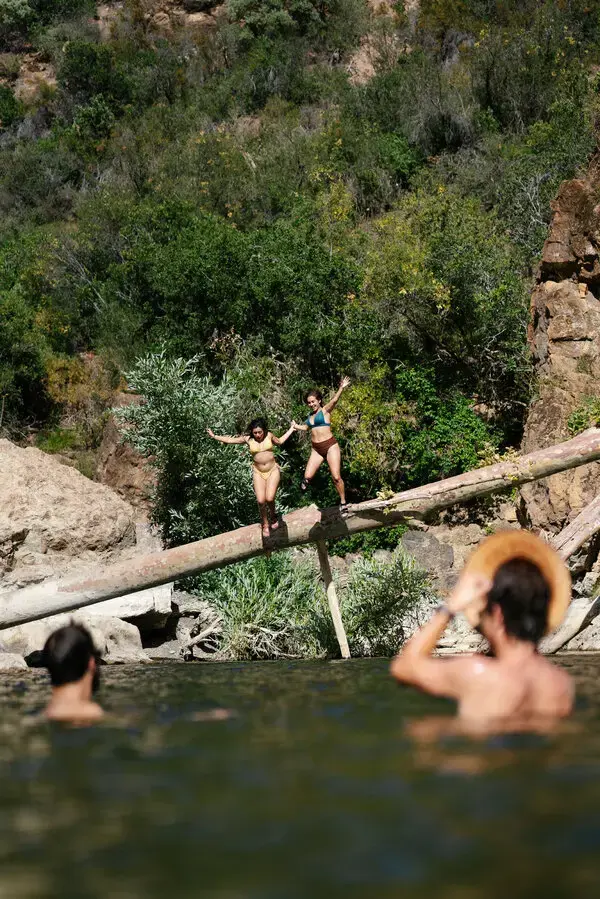
5. Big Sur River Gorge, Pfeiffer Big Sur State Park
For about 90 miles along the Pacific Coast, California’s Highway 1 bravely navigates the steep slopes of the Santa Lucia Range. People are often so preoccupied with driving the famed Big Sur region that they forget about stopping. But hiding among the many inland ridges and creeks are trails, campgrounds, and swimming holes — the best of them is Big Sur River Gorge in Pfeiffer Big Sur State Park ($10 day use fee). It’s not a secret spot, yet many people drive past.
The park’s 11-acre campground sits under a canopy of redwood trees as it straddles the Big Sur River in a sunny, alluvial valley. Day-use visitors can park at lot No. 3 to reach the Gorge Trail, which starts between campsites 111 and 112; an unmaintained path follows the river upstream for about a mile of wading and rock-hopping.
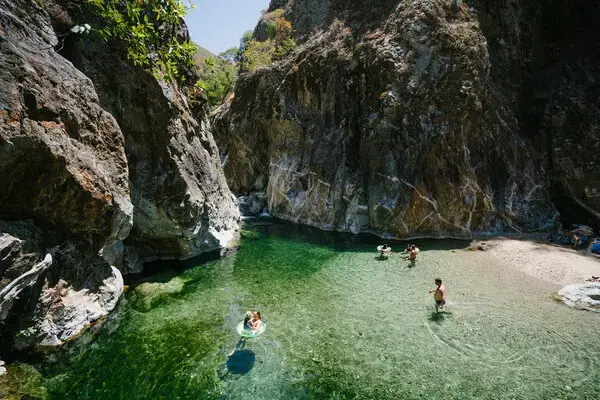
On our first visit, we asked a park ranger for directions. He said, “keep hiking until you get to the most beautiful pool you’ve ever seen.” He wasn’t far off. The river abruptly spills into a huge, natural amphitheater where the water is shockingly clear and deceptively deep. One after another, people arrive and stand for a moment of stunned reverence before huge smiles bloom across their faces. Like much of Big Sur, the phone service is thankfully terrible, so there is nothing to do but jump in and enjoy the day. (Portions of Highway 1 have been closed because of rock slides; access to Pfeiffer Big Sur State Park from the north is currently unaffected.)
6. Tecopa Hot Springs
Our search for natural hot springs took us to luxury spas, silent meditation centers, nudist colonies, and, of course, pristine wilderness areas. California has it all. And yet, Tecopa, an unassuming township near the Nevada border, just south of Death Valley National Park, remains one of the most memorable places we’ve ever visited. This, unlike the others, is one to bookmark for winter, as summer temperatures regularly exceed 112 degrees.
Set in the badlands of the Mojave Desert, the town has a surprising bounty of hot springs along with scattered palms, rusted cars, and sun-bleached ranch homes. Mineral-rich hot water bursts from the ground to create a ribbon of natural wetland and supply four (at last count) small resorts and bathhouses. Delights Hot Spring Resort ($25 day pass) has the best views of the Nopah mountain range from its large communal outdoor pool, while Tecopa’s austere public bathhouse ($10 day pass) has the hottest water in town. The latter is single-sex nude bathing only, like a Japanese communal bathhouse.
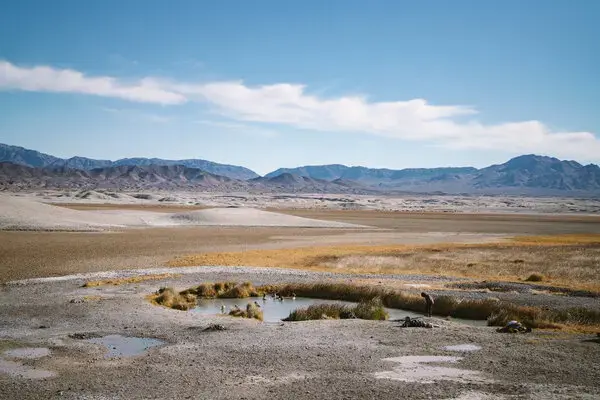
For a town of 100 or so, there is a surprisingly varied culinary offering — barbecue, breweries, a five-seater steakhouse (reservations required), a cafe, and the nearby China Ranch Date Farm — all operating different hours to avoid too much competition. We even heard a rumor about a nightclub. It’s the kind of place that will keep surprising you, which is what always brings us back.


